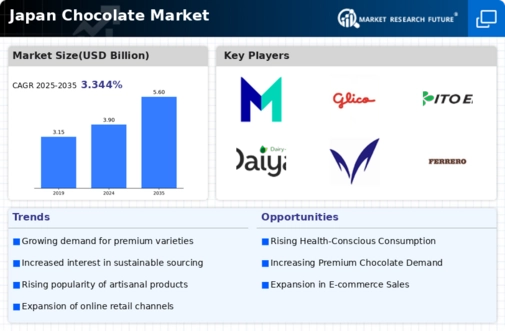The chocolate market in Japan exhibits a dynamic competitive landscape characterized by a blend of traditional and innovative strategies among key players. Major companies such as Mars Inc (US), Mondelez International (US), and Nestle SA (CH) are actively shaping the market through various strategic initiatives. Mars Inc (US) has focused on expanding its product portfolio with a strong emphasis on health-conscious options, which aligns with the growing consumer demand for healthier snacks. Meanwhile, Mondelez International (US) has been enhancing its digital marketing efforts, leveraging e-commerce platforms to reach a broader audience. Nestle SA (CH), on the other hand, has been investing in sustainable sourcing practices, which not only cater to environmentally conscious consumers but also strengthen its brand reputation in a competitive market.
The business tactics employed by these companies reflect a concerted effort to optimize supply chains and localize manufacturing processes. The market structure appears moderately fragmented, with a mix of large multinational corporations and smaller, niche players. This fragmentation allows for diverse product offerings, yet the collective influence of the major players is significant, as they set trends and standards that smaller companies often follow.
In October 2025, Ferrero Group (IT) announced a strategic partnership with a local Japanese confectionery firm to enhance its distribution network. This move is likely to bolster Ferrero's market presence in Japan, allowing for more tailored product offerings that resonate with local tastes. Such partnerships may also facilitate better supply chain efficiencies, which are crucial in a market where consumer preferences can shift rapidly.
In September 2025, Lindt & Sprüngli AG (CH) launched a new line of premium chocolate products specifically designed for the Japanese market, incorporating local flavors such as matcha and yuzu. This strategic introduction not only showcases Lindt's commitment to innovation but also highlights the importance of cultural adaptation in product development. By aligning its offerings with local preferences, Lindt positions itself as a premium choice among discerning consumers.
In August 2025, Godiva Chocolatier (BE) unveiled a new sustainability initiative aimed at reducing its carbon footprint by 30% by 2030. This initiative underscores the growing trend towards sustainability within the chocolate market, as consumers increasingly favor brands that demonstrate environmental responsibility. Godiva's proactive approach may enhance its brand loyalty and attract a demographic that prioritizes ethical consumption.
As of November 2025, the competitive trends within the chocolate market are increasingly defined by digitalization, sustainability, and the integration of artificial intelligence in operations. Strategic alliances are becoming more prevalent, as companies recognize the value of collaboration in navigating complex market dynamics. Looking ahead, competitive differentiation is likely to evolve from traditional price-based strategies to a focus on innovation, technological advancements, and reliable supply chains. This shift suggests that companies that prioritize these areas will be better positioned to thrive in an ever-evolving market.






















Leave a Comment